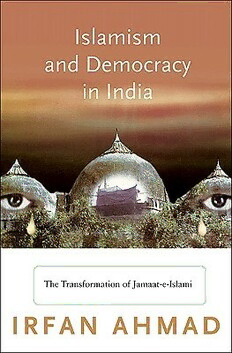
Islamism and Democracy in India: The Transformation of Jamaat-E-Islami PDF
Preview Islamism and Democracy in India: The Transformation of Jamaat-E-Islami
Islamism and Democracy in India princeton studies in muslim politics Dale F. Eickelman and Augustus Richard Norton, Editors Diane Singerman, Avenues of Participation: Family, Politics, and Networks in Urban Quarters of Cairo Tone Bringa, Being Muslim the Bosnian Way: Identity and Community in a Central Bosnian Village Dale F. Eickelman and James Piscatori, Muslim Politics Bruce B. Lawrence, Shattering the Myth: Islam beyond Violence Ziba Mir-Hosseini, Islam and Gender: The Religious Debate in Contemporary Iran Robert W. Hefner, Civil Islam: Muslims and Democratization in Indonesia Muhammad Qasim Zaman, The Ulama in Contemporary Islam: Custodians of Change Michael G. Peletz, Islamic Modern: Religious Courts and Cultural Politics in Malaysia Oskar Verkaaik, Migrants and Militants: Fun, Islam, and Urban Violence in Pakistan Laetitia Bucaille, Growing up Palestinian: Israeli Occupation and the Intifada Generation Robert W. Hefner, editor, Remaking Muslim Politics: Pluralism, Contestation, Democratization Lara Deeb, An Enchanted Modern: Gender and Public Piety in Shi`I Lebanon Roxanne L. Euben, Journeys to the Other Shore: Muslim and Western Travelers in Search of Knowledge Robert W. Hefner and Muhammad Qasim Zaman, eds., Schooling Islam: The Culture and Politics of Modern Muslim Education Loren D. Lybarger, Identity and Religion in Palestine: The Struggle between Islamism and Secularism in the Occupied Territories Augustus Richard Norton, Hezbollah: A Short History Bruce K. Rutherford, Egypt after Mubarak: Liberalism, Islam, and Democracy in the Arab World Irfan Ahmad, Islamism and Democracy in India: The Transformation of Jamaat-e-Islami Islamism and Democracy in India The Transformation of Jamaat-e-Islami Irfan Ahmad p r i n c e to n u n i v e rs i t y p r e s s p r i n c e to n a n d ox f o r d Copyright © 2009 by Princeton University Press Published by Princeton University Press, 41 William Street, Princeton, New Jersey 08540 In the United Kingdom: Princeton University Press, 6 Oxford Street, Woodstock, Oxfordshire OX20 1TW All Rights Reserved Library of Congress Cataloging-in-Publication Data Ahmad, Irfan, 1974– Islamism and democracy in India : the transformation of Jamaat-e-Islami / Irfan Ahmad. p. cm. — (Princeton studies in Muslim politics) Includes bibliographical references and index. ISBN 978-0-691-13919-7 (hardcover : alk. paper) — ISBN 978-0-691-13920-3 (pbk. : alk. paper) 1. Jama’at-i Islami (India) 2. Jama’at-i Islami (India)—Political activity. 3. Islam and politics—India. 4. Islam and secularism—India. 5. India—Politics and government. 6. Democracy—Religious aspects—Islam. I. Title. BP10.J343A46 2009 324.254'082—dc22 2009011056 British Library Cataloging-in-Publication Data is available This book has been composed in Sabon Printed on acid-free paper. ∞ press.princeton.edu Printed in the United States of America 10 9 8 7 6 5 4 3 2 1 TO Ammˉı (Najma Khatoon) Abbˉı jˉı (Fazil Ahmad) & Bhikhaˉri bhaˉˉı (Bhikhari Paswan) ¯ ¯ The simple truth is that whenever religion gets into society’s driving seat, tyranny results. Salman Rushdie, The Guardian, March 18, 2005 Religion is like a candle that can illuminate one’s cottage; it can also set it on fire: the choice is one’s own, what use is made of it. Persian adage, in Partha S. Ghosh, BJP and the Evolution of Hindu Nationalism Contents List of Illustrations and Tables ix Preface and Acknowledgments xi Notes to the Reader xvii Abbreviations xix Introduction 1 Part I. Fieldwork and Historical Context 1. Doing Fieldwork in Times of War 31 2. Contextualizing the Formation and Ideology of Islamism 49 Part II. Zigzags to Allah’s Kingdom 3. Educating the Children 83 4. Mobilizing the Young 111 5. Defining Islam: Conflict and Democratization 137 Part III. Opposition and Negotiation 6. Invoking Jihad 163 7. Negotiating the Idol: Secularism, Democracy, and Allah’s Kingdom 188 Conclusion 217 Appendixes 241 Notes 245 Glossary of Urdu-Hindi Terms 263 Bibliography 265 Index 295 Illustrations and Tables Maps 1. India xxii 2. Aligarh showing the shahr and Civil Line 38 3. Map of Uttar Pradesh showing its districts 45 Figures 1. The many faces of Maududi 55 2. Ja¯me Masjid in Aligarh shahr 86 3. Children at the Green School offering the morning prayer 101 4. Signboard of the SIO’s office at Aligarh Muslim University, Aligarh 115 5. The SIO’s wall magazine on the demolition of the Babri mosque 123 6. Mosque on the campus of the Jamaat’s madrasa, Ja¯miatul Fala¯h, Azamgarh 140 ˙ 7. The SIMI’s portrayal of the horror of anti-Muslim violence in its organ, Islamic Movement 176 8. The SIMI’s wall slogan pledging to rebuild the Babri mosque 178 9. Islamic Movement’s depiction of the Indian political system as a “secular circus” 182 10. The SIMI’s calendar with its radicalized motto 186 11. The BJP’s election poster featuring the SIMI’s ban 189 Graph 1. Number of students from 1971 to 1986, Green School 92 Tables 1. Number of Members and Associates of SIO, AMU Unit 1997 to 2002 113 2. Number of a¯lm¯ıyat and faz¯ılat Students at Fala¯h 143 ˙ ˙ 3. Voting criteria for Jamaat Members 203 4. Organizational Strength of the Jamaat from 1941 to 2000 241 5. Organizational Strength of the SIO from 1983 to 2001 242 6. Organizational Strength of the SIMI from 1977 to 1996 243
